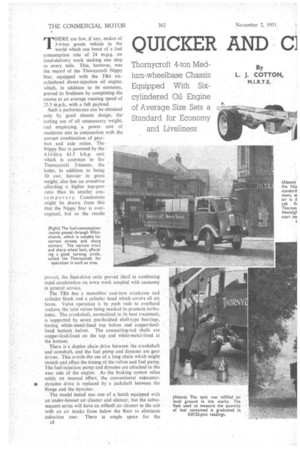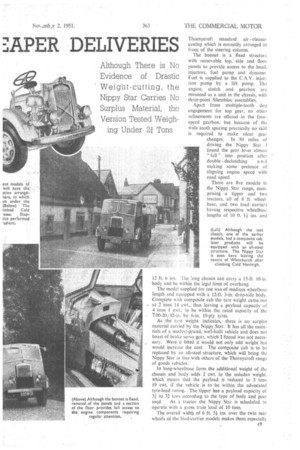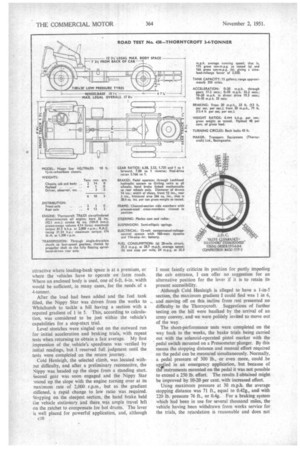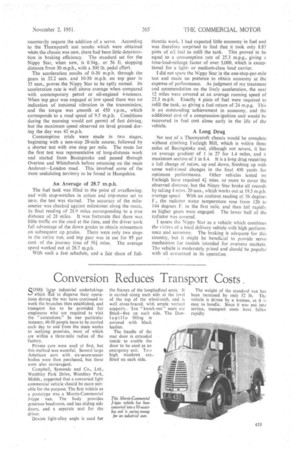QUICKER AND a 3APER DELIVERIES
Page 46

Page 47

Page 48

Page 49

If you've noticed an error in this article please click here to report it so we can fix it.
By 1. J. COTTON, m.i.R.T.E.
Thornycroft 4-ton Medium-wheelbase Chassis Equipped With Sixcyhndered Oil Engine of Average Size Sets a Standard for Economy and liveliness Although There is No Evidence of Drastic Weight-cutting, the Nippy Star Carries No Surplus Material, the Version Tested Weigh ing Under 21 Tons
THERE are few, if any, makes of 3-4-ton goods vehicle in the world which can boast of a fuel consumption rate of 24 m.p.g. on local-delivery work making one stop to every mile. This, however, was the record of the Thornycroft Nippy Star, equipped with the TR6 sixcylindered direct-injection oil engine, which, in addition to its economy, proved its liveliness by completing the course at an average running speed of 25.3 m.p.h., with a full payload.
Such a performance can be obtained only by good chassis design, the cutting out of all unnecessary weight, and employing a power unit of moderate size in conjunction with the correct combination of gearbox and axle ratios. The Nippy Star is powered by the 4.14-litre 61.5 b.h.p. unit which is common to the Thornycroft 5-tonner, the latter, in addition to being 30 cwt, heavier in gross weight, also has an overdrive affording a higher top-gear ratio than its smaller cont em porar y. Conclusions might be drawn from this that the Nippy Star is overengined, but as the results
proved, the final-drive ratio proved ideal in combining rapid acceleration on town work coupled with economy in general service.
The TR6 has a monobloc cast-iron crankcase and cylinder block and a cylinder head which covers all six bores. Valve operation is by push rods to overhead rockers, the inlet valves being masked to .promote turbulence. The crankshaft, normalized in its heat treatment, is supported by seven pre-finished shell-type bearings, having white-metal-lined top halves and copper-leadlined bottom halves. The connecting-rod shells are copper-lead-lined on the top and white-metal-lined at the bottom.
There is a duplex chain drive between the crankshaft and camshaft, and the fuel pump and dynamo are gear driven.. This avoids the use of a long chain which might stretch and affect the timing of the valves and fuel pump. The fuel-injection pump and dynamo are attached to the near side of the engine. As the braking system relies • solely on manual effort, the conventional exbauster • dynamo drive is replaced by a jackshaft between the flange and the dynamo.
The model tested was one of a batch equipped with an under-bonnet air Cleaner and silencer, but the subsesequent series will have in oilbath air cleaner in the cab with an air intake from below the floor to eliminate induction roar. There is ample space for the Thornycroft standard air cleaner casting which is normally arranged in front of the steering column.
The bonnet is a fixed structure with removable top, side and floor panels to provide access to the head. injectors, fuel pump and dynamo Fuel is supplied to the C.A.V.. injection pump by a lift pump. The engine, clutch and gearbox are mounted as a unit in the chassis, with three-point Silentbloc assemblies.
Apart from multiple-tooth dog engagement for top gear, no other refinements are offered in the fourspeed gearbox, but because of the wide tooth spacing practically no skill is required to make silent gear changes. In 80 miles of driving the Nippy Star I found the gear lever almost " fell" into position after
double-declutching a n d making some pretence of aligning engine speed with road speed.
There are five models in the Nippy Star range, comprising a tipper and two tractors, all of 8 ft. wheelbase, and two load carriers having respective wheelbase lengths of 10 ft. 11 ins, and 12 ft. 6 ins. The '.ong chassis can carry a 15-ft [0-in. body and be within the legal limit of overhang.
The model supplied for test was of medium wheelbase length and equipped with a 12-ft. 3-in, drop-side body. Complete with composite cab the tare weight came out at 2 tons 14 cwt., thus leaving a payload capacity of 4 tons 1 cwt., to be within the rated capacity of the 7.00-20/32-in. by 6-in. 10-ply tyres.
As the tare weight indicates, there is no surplus material carried by the Nippy Star. It has all the essentials of a modest-priced, well-built vehicle and does not boast of brake servo gear, which I found was not neces, sary. Were it fitted it would not only add weight but would increase the cost. The conip,osite cab is to be replaced by an all-steel structure, which will bring th,:. Nippy Star in line with others of the Thornycroft range of goods vehicles.
In long-wheelbase form the additional weight of the chassis and body adds 2 cwt. to the unladen weight, Which means that the payload is reduced to 3 tons 19 cwt. if the vehicle is to be within the advocated tyre-load rating: The tipper has a payload capacity of 31 to 31 tons according to the type of body and gear used. As a tractor the Nippy Star is scheduled to operate with a gross train load of 10 tons.
The overall width of 6 ft. 51 ins, over the twin rear wheels of the load-carrier models makes them especially attractive where loading-bank space is at a premium, or where the vehicles have to operate on farm roads. Where an enclosed body is used, one of 6-ft. 6-in, width would be sufficient, in many cases, for the needs of a 4-tonner.
After the load had been added and the fuel tank filled, the Nippy Star was driven from the works to Whitchurch to tackle a hill having a section with a reputed gradient of 1 in 5. This, according to calculation, was considered to be just within the vehicle's capabilities for a stop-start trial.
Level stretches were singled out on the outward run for initial acceleration and braking trials, with repeat tests when returning to obtain a fair average. My first impression of the, vehicle's speediness was verified by initial readings, but I reserved full judgment until the tests were completed on the return journey.
Cold Henleigh, the selected climb, was located withput difficulty, and after a preliminary reconnoitre, the Nippy was headed up the slope from a standing start. Second gear was soon engaged and the Nippy Star -oared up the slope with the engine turning over at its rtaximum rate of 2,000 r.p.m., but as the gradient itiffened, a rapid change to low ratio was required. Stopping on the steepest section, the hand brake held ale vehicle stationary 'and there was ample travel ltft on the ratchet to compensate for hot drums. The lever is well placed for powerful application, and, although
cI0 I must faintly criticize its position for partly impeding the cab entrance, I can offer no suggestion for an alternative position for the lever if it is to retain its present accessibility.
Although Cold Henleigh is alleged to have a 1-in-5 section, the maximum gradient I could find was 1 in 6, and moving off on this incline from rest presented no difficulty to the Thornycroft. Suggestions of further testing on the hill were baulked by the arrival of an army convoy, and we were politely invited to move out of the way.
The short-performance tests were completed on the way back to the works, the brake trials being carried out with the solenoid-operated pistol marker with the pedal switch mounted on a Pressometer plunger. By this means the stopping distance and manual effort required on the pedal can be measured simultaneously. Normally, a pedal pressure of 300 lb., or even more, could .be apulied in an emergency application, but because of thEinstruments mounted on the pedal it was not possible to exceed a 250 lb. effort. The results I obtained might be improved by 10-20 per cent, with increased effort.
Using maximum pressure at 30 m.p.h. the average stopping distance was 71 ft., equal to 0,42g., and with 220 lb. pressure 76 ft., or 0.4g. For a braking system which had been in use for several thousand miles, the vehicle having been withdrawn from works service for the trials, the retardation is reasonable and does not necessarily require the addition of a servo. According to the Thornycroft test results which were obtained when the chassis was new, there had been little deterioration in braking efficiency. The standard set for the Nippy Star, when new, is 0.54g., or 56 ft. stopping distance from 30 m.p.h., with a 300 lb. pedal effort.
The acceleration results of 0-30 m.p.h. through the gears in 32.2 secs. and 10-30 m.p.h. on top gear in 35 secs., proves the Nippy Star to be aptly named. Its acceleration rate is well above average when compared with contemporary petrol or oil-engined 4-tonners. When top gear was engaged at low speed there was no indication of torsional vibration in the transmission, and the torque was smooth at 450 r.p.m., which corresponds to a road speed of 9.5 m.p.h. Conditions during the morning would not permit of fast driving, but the maximum speed observed on level ground during the day was 42 m.p.h.
Consumption trials were made in two stages, beginning with a non-stop 28-mile course, followed by a shorter test with one stop per mile. The route for the first test was representative of long-distance work and started from Basingstoke and passed through Overton and VVhitchurch before returning on the main Andover—London road. This involved some of the most undulating territory to be found in Hampshire.
An Average of 28.7 m.p.h.
The fuel tank was filled to the point of overflowing, and with stop-watches in action and trip-meter set to zero, the test was started. The accuracy of the mileometer was checked against milestones along the route, its final reading of 28.9 miles corresponding to a true distance of 28 miles. It was fortunate that there was little traffic on the road at the time, and the driver took full advantage of the down grades to obtain mOmentunt on subsequent up grades. There were only two stops in the entire run, and top gear was in use for 95 per cent. of the journey time of 58i mins. The average speed worked out at 28.7 m.p.h.
With such a fast schedule, and a fair share of full throttle work. I had expected little economy in fuel and was therefore surprised to find that it took only 8.85 pints of oil fuel to refill the tank, This proved to be equal to a consumption • rate of 25.3 m.p.g., giving a time-load-mileage factor of over 5,000, which is exceptional for a lightor medium-class load carrier.
I did not spare the Nippy Star in the one-stop-per-mile test and made no pretence to obtain economy at the expense of performance. As judgment of my treatment and commendation on the lively acceleration, the next 12 miles were covered at an average running speed of 25.3 m.p.h. Exactly 4 pints of fuel were required to refill the tank, so giving a fuel return of 24 m.p.g. This is an outstanding achievement in economy, and the additional cost of a compression-ignition unit would be recovered in fuel cost alone early in the life of the vehicle.
A Long Drag No test of a Thornycroft chassis would be complete without climbing Farleigh Hill, which is within three miles' of Basingstoke and, although not severe, it has an average gradient of 1 in 27 for 1.4 miles, and a maximum section of 1 in 8.4. It is a long drag requiring a full change of ratios, up and down, finishing up with some well-timed changes in the final 400 yards for optimum performance. Other vehicles tested on Farleigh have required 4-i mins. or more to cover the observed distance, but the Nippy Star broke all records by taking 4 mins. 20 secs., which works out at 19.3 m.p.h. average speed. With an ambient reading of 56 degrees F., the radiator water temperature rose from 120 to 144 degrees F. in the first mile, and then fell rapidly as higher gears were engaged. The lower half of the radiator was covered.
I assess the Nippy Star as a vehicle which combine; the viroics of a local delivery vehicle with high performenc.:. and economy, The braking is adequate for this country, but it might be beneficial to provide servo mechanism for models intended for overseas markets. The vehicle is moderately priced and should be popular with all concerned in its operation.




























































































